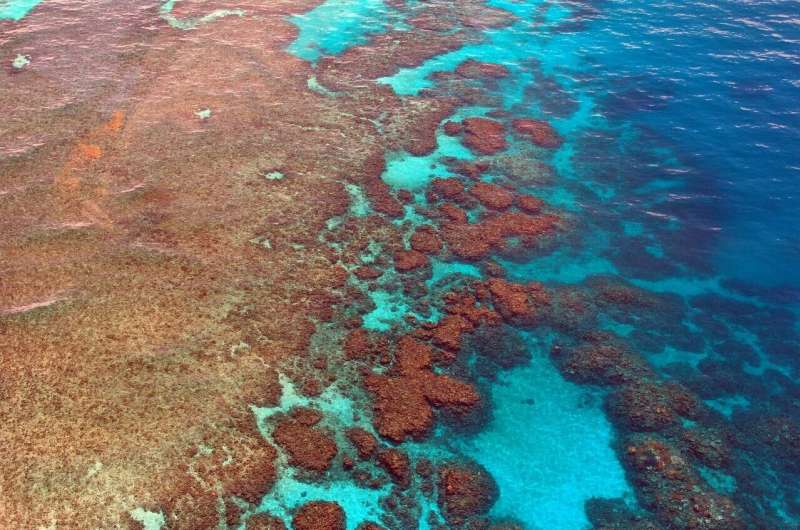This article has been reviewed according to Science X's editorial process and policies. Editors have highlighted the following attributes while ensuring the content's credibility:
fact-checked
proofread
Unlocking the secrets of natural reef recovery

Corals, the literal foundation of any reef, have adjusted and adapted to their environment over millennia. Yet with rapid global warming, the key question is whether their natural resilience can keep up with this extreme environmental change.
While reefs can recover from adverse conditions, sadly the ongoing frequency and severity of stressors like marine heat waves means they cannot recover fast enough. Boosting a reef's natural resilience and ability to recover in the face of continued and increasing climate change stress is necessary.
Connectivity
Despite continued stress and mass bleaching events in the last decades, the Great Barrier Reef remains viable, thanks in part to its secret self-recovery ability—connectivity.
Like a forest that continues to grow as new seeds are sown, each year during spawning events, fertilized coral larvae travel, settle and replenish Reef populations. Being so tiny, larvae move on the currents that flow from reef to reef, creating pathways rather like the highways that connect cities. The larval connections among reefs are referred to as the ecosystem's connectivity. It is this that maintains biodiversity and ensures reefs continue to thrive.
Yet not all reefs are created equal. Research suggests that due to their location and the density of resident reproducing corals, a small percentage of reefs can replenish corals on almost half of the Great Barrier Reef.
In a vast and complex system like the Great Barrier Reef, made up of over 3000 individual reefs, the scale at which we need to unlock natural resilience and restore the Reef can feel overwhelming. Thanks to natural connectivity, we know we can strategically target our efforts to 100–200 highly connected reefs, to create a domino effect and start shifting long-term trends of recovery, even in the face of decimation of a local coral population.
Predicting where these "larval supply hub" reefs are is part of the work of specialized ecological intelligence teams in the Reef Restoration and Adaptation Program.
Surviving year one
Imagine a reef as a battlefield, with baby corals the valiant heroes. They must survive encrusting algae that crowd the ocean floor, hungry predators, waves that shift destructive rocks and rubble, and the hot sun that beats down extreme heat and light. It's no wonder that just one in every million tiny coral larvae make it through their first year without intervention.
Right now, Reef researchers are investigating all the factors that hinder or help baby corals at each life stage, from fertilization to settlement and early growth. We can use that information to enhance survival and improve the odds:
We now understand many of the factors that can inhibit or encourage a coral larva to settle onto a particular surface. By placing newly settled corals into specially designed predator-proof 'coral cradles' that also limit algae growth, we are seeing improvements in survival once they are deployed in certain reef habitats.
The perfect habitat
Any visitor to our Great Barrier Reef knows that no one reef looks like the other. Their beauty—and their strength—is in their diversity. While we refer to it as a single ecosystem, the Reef extends for thousands of kilometers and contains myriad of micro habitats. Certain coral types grow in abundance in particular areas, others elsewhere, and each provide homes for particular types of fish and other marine life.
Understanding how corals grow in a particular Reef habitat helps us to decide where and how we can best and most efficiently restore a reef with new baby corals.
That's where ecological intelligence can help. Detailed monitoring using instruments like long-term pH and wave sensors gives us insights into the chemical and biological features of Reef sites that influence coral growth and recovery. Detailed surveying techniques like 3D photo-mapping provide further in-depth insights.
Researchers use rigs called mapping platforms with multiple cameras to take overlapping photos of Reef landscapes. They upload the images to a specialized software program that converts them into 3D maps.
The technique is being used underwater and is proving to be a quick, precise, non-invasive way to map large areas of the Reef, which is crucial when you have limited time out on the water.
We can determine the physical characteristics such as the volume of corals, as well as the distance between corals of the same species, from these 3D maps and when we revisit sites, we can measure changes over time.
These are important factors in how reefs respond to disturbances in their environment and provides vital data to enhance natural recovery through restoration.
Provided by Great Barrier Reef Foundation




















